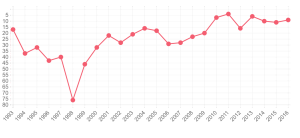Page by: Andrew Cho. Apr 2016
.jpg)
“El Celeste”
Current FIFA Ranking: 9
Copa America Record: Champion (15), Appearance (40)
Manager: Oscar Tabarez (Uruguay)
Uruguay FIFA Ranking since 1993. Graph by FIFA
History
In the early to mid 20th century, Uruguay was at the pinnacle of soccer (Nadel, Chapter 1). Even as a relatively small country in population and size compared to its neighbors Brazil and Argentina, Uruguay prided itself in its soccer prowess. In Nadel’s words, “Fighting against the giants of Europe and South America, tiny Uruguay, with its garra, always showed its ability to compete with its more powerful opponents.” Their nickname, “The Celeste”- which is “sky blue” in Spanish- originated from the spectacular years in 1910 and 1912 that Uruguay defeated the mighty Argentina multiple times and dominated the neighbor rivalry (Nadel 33). The color and nickname has stuck since then and has become a sort of national symbol.
Then starting around 1970, the dominance of El Celeste began to recede. This reached an all-time low of FIFA rank 76 in 1998, following failures to qualify for the 94 and 98 World Cups. However, since then a new generation of Uruguayan superstars were born, and as seen on the graph above, Uruguay has steadily been on the rise back to one of the best in the world. Stars like Luis Suarez and Diego Forlan rose to the spotlight and lead the way in paving Uruguay to its world-class glory. In the 2011 Copa America, Uruguay defeated Paraguay in a stunning 3-0 score, and it was only fitting that Suarez and Forlan each scored one and two in the championship match. More recently, however, Uruguay fell to neighbor Colombia in the Round of 16 in the 2014 Brazil World Cup.
Soccer fans around the world can certainly expect a motivated El Celeste squad this summer. A writer at ESPN FC predicted Uruguay as favorites to win the Copa America (Vickery, 2016).
Player to Watch
Luis Suarez (29)
 Photo by Wikipedia. Labeled for reuse.
Photo by Wikipedia. Labeled for reuse.
- Club: FC Barcelona
- National Caps: 84
- Goals: 45
It would be an understatement to say that Suarez is having a spectacular season. As of the 20th of April, Suarez has scored 49 goals for Barcelona this season, 30 in the league. This 49 figure is equal to the goals Harry Kane (27) and Jamie Vardy (22) put together this season for their respective clubs. It is also 49 goals in 48 appearances (BBC, 2016). It may not be a bold prediction to think that Suarez will score a few goals for Uruguay this summer in the Copa America.
Chants
- “Soy Celeste”
This uniquely Uruguayan chant is a simple one, yet highly memorable. Even a non-Uruguayan can learn the easy, catchy tune and find themselves singing along. The chant translates to “I am celeste, I am celeste, Celeste I am.” On the top of this page, we discussed the significance of the word “celeste” to Uruguayans. They truly take the word to heart. Celeste, or “sky blue”, is their passion, soul, and nationality. It is them. It is Uruguay (Fan Chants, 2013).
The “Ole, Suarez” chant is a derivation of the famous “Ole” chant we all know. Similar to the “Ole, Messi” chant, the Suarez version is simply fans singing, “Ole, ole, ole, oleeee… Suarez, Suarez.” Considering Suarez’s contribution to the national team, this may not be surprising at all.
National Narrative
The last time Uruguay lifted a globally competitive trophy was in the 2011 Copa America in Argentina. Uruguayans surely remember that year when they beat archrivals Argentina in the quarterfinals in their own turf and went on to win the entire tournament. This title also secured Uruguay an uncontested position as the “country with the most Copa America titles”, now having one more than Argentina.
The Uruguayan soccer writer Eduardo Galeano writes a particularly interesting quote in his book “Soccer in Sun and Shadow.” “For the fanatic, pleasure comes not from your own club’s victory, but from the other’s defeat” (Galeano, p125). No doubt Uruguayan fans cheered in El Celeste’s victory. But they may have cheered even harder knowing this put Argentina as “number two” in the history books of Copa America. Of course it is only fitting that Uruguay’s title happened in Argentina.
Galeano, however, expresses this in a latter part of the book. “Many of us Uruguayans embraced the chance to die of something other than boredom, and the country’s streets became a fiesta. After all, the right to celebrate one’s own merits is always preferable to the pleasure some derive from the misfortune of others” (p267). Soccer fuels El Celeste. It causes fiestas on the streets and ignites passion in the nation.
The tournament this summer could be crucial in holding that place and national pride, especially in the 100th year anniversary of Uruguay’s best competition. For over a century, the Celeste has held onto soccer as its glory and spot in South America, even in between massive neighbors Brazil and Argentina. The Celeste is and never has been afraid, and a triumphant win in the Copa America Centenario will no doubt solidify their place in the continent.
Works Cited:
Galeano, Eduardo. Soccer in the Sun and Shadow. New York: Nation Books, 2013. Print
“Luis Suarez: Striker is as prolific as Harry Kane and Jamie Vardy put together” BBC. 21 Apr 2016. Web 21 Apr 2016. http://www.bbc.com/sport/football/36100322.
Nadel, Joshua. Futubol. Gainesville:University Press of Florida, 2014. Print
“Soy Celeste.” Fan Chants. 13 Nov. 2013. Web 20 Apr 2016. http://en.uruguay.fanchants.com/football-songs/uruguay-chants/i-am-celeste/
Vickery, Tim. “Copa America predictions: US group wide open, Brazil and Mexico to cruise” ESPNFC. 21 Feb 2016. Web 20 Apr 2016. http://www.espnfc.us/copa-america/83/blog/post/2812269/copa-america-centenario-group-predictions.
How to Cite this page:
“Uruguay” Written by Andrew Cho (22 April 2016), Copa America Centenario 2016, Soccer Politics Blog, Duke University http://sites.duke.edu/wcwp/tournament-guides/copa-america-centenario-2016-guide/copa-america-centenario-2016-team-guide/uruguay-group-c/ (accessed on (date))

